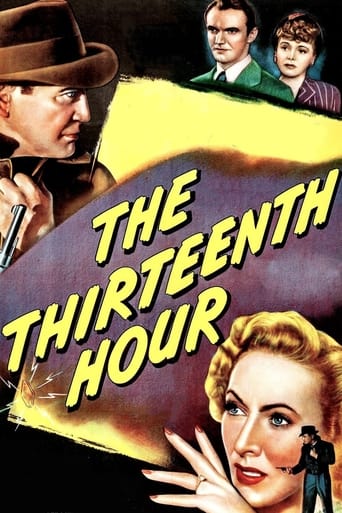MartinHafer
"The Thirteenth Hour" is the final installment of The Whistler series which starred Richard Dix. Sadly, shortly after making the movie, Dix died of a heart attack at age 56.When the story begins, Steve Reynolds (Richard Dix) owns a small trucking company and life is just fine. However, he's in for a horrible time...and it all begins when he picks up a hitchhiker. His car is run off the road and there is no obvious evidence that another driver was involved. Steve tells the cops to ask the hitchhiker what happened...and the man disappeared! The court believes Steve was drunk and they take away his license...and it's obvious the cops have it out for Steve. Soon after, Steve is deliberately set-up for murder when an unknown person runs over a policeman in Steve's truck. Steve is knocked out and stuck behind the wheel...and the police think he's a killer. So, he runs away before the police can apprehend him and he spends the rest of the film trying to discover who is doing all this to him and why. The only clue he has is a glove.This is an enjoyable and well written installment of this B-movie series. Not among the very best but quite good and well worth seeing.
utgard14
The penultimate entry in Columbia's Whistler series and the last to star Richard Dix. This final Dix Whistler movie isn't one of the best but it's still worth a look. The story is fairly straightforward with Dix playing more of a typical protagonist than in other entries where he played more morally ambiguous characters. This time he's a truck driver out to clear his name when he's framed for killing a policeman.Karen Morley is good as Dix's girlfriend. Regis Toomey plays a small but important part as the cop Dix is accused of killing. Mark Dennis is unintentionally funny as Morley's son, who reads books on necrophobia and warns cops "That's mama's and my bedroom. We don't like anybody going in there." John Kellogg, Jim Bannon, and Bernadene Hayes round out the significant roles in the cast. For his part, Dix is solid as usual.As I said, this is the last Whistler movie that Dix made, but it's also his last film period. He retired after this and died two years later. With a career stretching back over twenty years into the silents, he's probably best remembered for his Oscar-nominated role in Cimarron or for playing the crazy captain in Val Lewton's The Ghost Ship. Lantern-jawed with a somewhat stiff line delivery, Dix may not have challenged Gable or Grant or Flynn in charisma or sex appeal but he had an interesting screen presence all his own. He certainly made his mark in the films I mentioned, as well as many others including this fine series based off the popular radio series The Whistler. His last film may not have been an example of "going out on top," but it was definitely nothing to be embarrassed about. Which is, unfortunately, more than you can say for some of his contemporaries' final films.
mark.waltz
In his last film, Richard Dix finds his life turned upside down thanks to rules and regulations for truck drivers that result in the suspension of his license. He finds that one drink is one too many thanks to another driver too busy trying to kiss his girlfriend than pay attention to the road. His only witness disappears seemingly into thin air after the truck veers off the road to avoid the other driver, crashing into a gas station ironically as a police officer reports in that nothing is going on. That officer, it turns out, is the rival for the affections of his waitress girlfriend (Karen Morley). Unable to drive after the trial with a suspended license, Dix finds himself the main suspect in the murder of his rival, seemingly linked to the trucking company Dix has started. The road to his clearing leads him straight to the path of...you guessed it...the Whistler.Dix helps a tricky, but intriguing story line, move along as a rather supernatural element takes over the organized crime hints. Who is that mysterious passenger who disappears? While only the whistler knows for sure, I suspected that he was actually the whistler guiding Dix to his destiny. Moving at a fast and furious speed, this has great character performances and moody photography as well to recommend it.
Spondonman
The 13th Hour was Richard Dix's 7th and final hour with the Whistler films; in fact he retired and died 2 years after this. It's not the best or the worst in the series, but still more than an adequate engrossing potboiler. It had the usual tight Columbia b picture budget yet atmospheric sets and photography plus the usual twisty story.Honest and dependable truck firm owner Dix suddenly finds himself guilty of causing damage through driving whilst under the influence of alcohol, but of course he's innocent. This being the Whistler means it goes from bad to worse, and wanted murderer Dix really has his back up against the wall for most of the picture trying to find the real culprits. If you're familiar with the tenor of the previous entries you can probably see the big twist a-coming, but the beautiful little twist just after will get you! Favourite bits: the atmospheric shots outside Eileen's café; the denouement inside and outside Mabel's apartment, unfortunately leading to a bit of a trite end.It wasn't quite the end of the dimly-lit road though – there was one more film to come (sans Dix) which wasn't too bad but the Canon is the 7 with him. All well worth watching if you prefer a simpler more complex world, when a b&w mystery film was just that and not a sex, violence, cgi cartoon riddled gimmick and hype fuelled socially inclusive seedy work of Art like nowadays.


